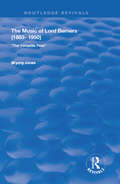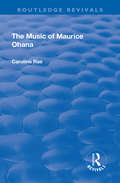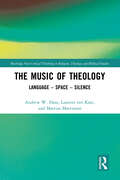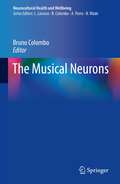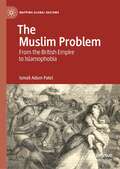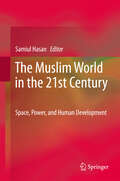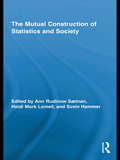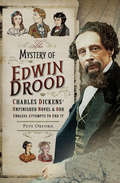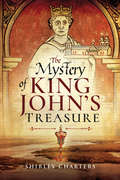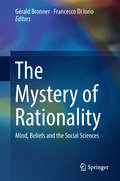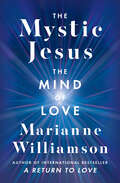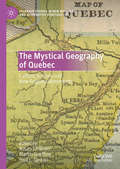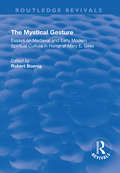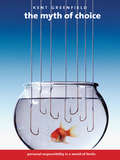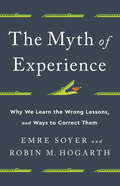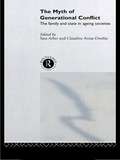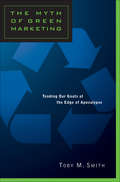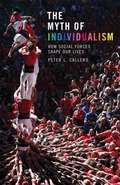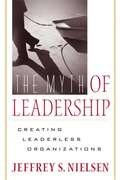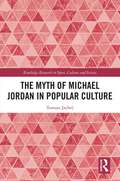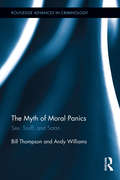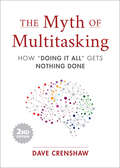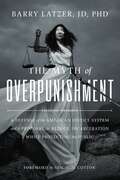- Table View
- List View
The Music of Lord Berners (1883-1950): The Versatile Peer
by Bryony JonesThis title was first published in 2003. Gerald Tyrwhitt-Wilson, the 14th Baron Berners, was a well-known figure in his day. Labelled by the national press as "the versatile peer", he was a composer, writer, painter and great socialite. His musical output was small, but highly successful in its day, with ballets staged in London, Monte Carlo and New York, an opera produced in Paris, and two film scores completed in the 1940s. These works, together with Berners' songs, his music for piano, and other instrumental pieces are given their first in-depth examination in this study. Bryony Jones shows how Berners' cosmopolitan musical style radically differed from that of many of his contemporaries who were concerned with creating a "national" music. Instead, Berners drew his inspiration from abroad, and comparisons are drawn with Les Six, and connections made with the work of Satie, Debussy and Ravel. Well-known for his elaborate practical jokes and sense of humour, Berners was an archetype of British eccentricity, and these aspects of his personality shaped much of his musical style. The book concludes with an attempt to explain why Berners' music was neglected following his death, and why there has been a recent resurgence of interest.
The Music of Maurice Ohana (Routledge Revivals)
by Caroline RaeThis title was first published in 2000. Pianist and scholar Rae presents a detailed study of composer Maurice Ohana's life and music, and identifies the procedures that characterize his mature style. In the initial chapters, she provides a biographical overview and sets his work in its musical and cultural context.
The Music of Theology: Language – Space – Silence (Routledge New Critical Thinking in Religion, Theology and Biblical Studies)
by Andrew Hass Mattias Martinson Laurens ten KateThis book reconceives theology as a musical endeavour in critical tension with language, space and silence. An Overture first moves us from music to religion, and then from theology back to music – a circularity that, drawing upon history, sociology, phenomenology, and philosophy, disclaims any theology of music and instead pursues the music in theology. The chapters that follow explore the three central themes by way of theory, music and myth: Adorno, Benjamin and Deleuze (language), Derrida, Rosa and Nancy (space), Schelling/Hegel, Homer and Cage (silence). In overdubbing each other, these chapters work towards theology as a sonorous rhythm between loss and freedom. A Coda provides three brief musical examples – Thomas Tallis, György Ligeti, and Evan Parker – as manifestations of this rhythm, to show in summary how music becomes the very pulse of theology, and theology the very intuition of music. The authors offer an interdisciplinary engagement addressing fundamental questions of the self and the other, of humanity and the divine, in a deconstruction of modern culture and of its bias towards the eye over the ear. The book harmonizes three scholarly voices who attempt to find where the resonance of our Western conceptions and practice, musically and theologically, might resound anew as a more expansive music of theology.
The Musical Neurons (Neurocultural Health and Wellbeing)
by Bruno ColomboThis book explores connections between music, neural activations and brain plasticity, in order to better understand its associated psychological and physiological effects. The final goal is to focus on the positive effects of music to treat neurological disorders, establishing a new co-ordination between different brain areas to improve both mental illness and wellbeing. A secondary goal is to analyse the role of music at a psycho-sociological level, to understand both the transformation of music into a cultural model and the vision of music as an innate instinct.Music is able to create both emotions and volitional processes. The application of new neuroimaging techniques allows us to explore and evaluate with accuracy what happens in our brain during the creative and artistic performance. A wide range of brain regions are recruited for creative tasks, and music has the opportunity to help in enhance and reset some brain pathological disturbances being also able to ameliorate and restore some rhythmic body activities such as sleep, movement and co-ordination. The book represents a valuable and innovative tool both for neurologists as well as healthcare professionals involved in the management of neurological disorders.
The Muslim Problem: From the British Empire to Islamophobia (Mapping Global Racisms)
by Ismail Adam PatelThis book explains the increasing incidences and normalisation of Islamophobia, by analysing the role of signifiers of free speech, censorship, and fatwa during the Satanic Verses affair in problematising the figure of the Muslim. Ismail Patel develops the notion of Islamophobia not as a continuation of the antagonistic relation from the British Empire but as a postcolonial reformulation of the figure of the Muslim. The book views Islamophobia studies as a paradigm, engages in the debate of Islamophobia as a global phenomenon, investigates the contestation over its definition and challenges the view of Islamophobia as a reserve of the far-right. It assesses the debate around the concept of identity and shows how the colonised figure of the Muslim provided significance in constructing British imperial identity. Providing a decolonial, counter-Islamophobia approach that challenges Britishness’ exclusionary white symbolic content, the book calls for a liberating idea of Britishness that promotes a post-racist rather than a post-race society. Theoretically rich in analysis, this book will contribute to discussions of identity formation, Britishness, Islamophobia and counter-Islamophobia. It will be of use to students and researchers across history, politics, sociology, cultural studies, literary studies, and anthropology.
The Muslim World in the 21st Century
by Samiul HasanIslam is not only a religion, but also a culture, tradition, and civilization. There are currently 1.5 billion people in the world who identify themselves as Muslim. Two thirds of the worldwide Muslim population, i.e. approximately a billion people, live in forty-eight Muslim majority countries (MMC) in the world- all of which except one are in Africa and Asia. Of these MMCs in Africa and Asia, only twelve (inhabited by about 165 million people) have ever achieved a high score on the Human Development Index (HDI), the index that measures life expectancy at birth, education and standard of living and ranks how "developed" a country is. This means that the majority of the world's Muslim population lives in poverty with low or medium level of human development. The contributions to this innovative volume attempt to determine why this is. They explore the influence of environment, space, and power on human development. The result is a complex, interdisciplinary study of all MMCs in Africa and Asia. It offers new insights into the current state of the Muslim World, and provides a theoretical framework for studying human development from an interdisciplinary social, cultural, economic, environmental, political, and religious perspective, which will be applicable to regional and cultural studies of space and power in other regions of the world.
The Mutual Construction of Statistics and Society (Routledge Advances in Research Methods)
by Ann Rudinow SætnanStatistics are often seen as simple, straightforward, and objective descriptions of society. However, what we choose to count, what we choose not to count, who does the counting, and the categories and values we choose to apply when counting, matter. This volume addresses the ways in which statistics and numbers are gathered and applied in social science research. The contributors argue that we must become more aware of the power and the limitations of statistics. Learning statistics needs to be about more than simply mastering the techniques of using the tool; it needs to also be about learning the dangers of that tool and learning to control it within social and ethical bounds. These dangers lie in the routines through which statistics are applied; the discourses from which they emerge and into which they are deployed; the power relations created by those discourses; and the assumptions, meanings, and categories statistics carry with them in those discourses. This volume will be necessary reading for students and scholars using quantitative data within the social sciences.
The Mystery of Courage
by William Ian MillerFew of us spend much time thinking about courage, but we know it when we see it--or do we? Is it best displayed by marching into danger, making the charge, or by resisting, enduring without complaint? Is it physical or moral, or both? Is it fearless, or does it involve subduing fear? Abner Small, a Civil War soldier, was puzzled by what he called the "mystery of bravery"; to him, courage and cowardice seemed strangely divorced from character and will. It is this mystery, just as puzzling in our day, that William Ian Miller unravels in this engrossing meditation. Miller culls sources as varied as soldiers' memoirs, heroic and romantic literature, and philosophical discussions to get to the heart of courage--and to expose its role in generating the central anxieties of masculinity and manhood. He probes the link between courage and fear, and explores the connection between bravery and seemingly related states: rashness, stubbornness, madness, cruelty, fury; pride and fear of disgrace; and the authority and experience that minimize fear. By turns witty and moving, inquisitive and critical, his inquiry takes us from ancient Greece to medieval Europe, to the American Civil War, to the Great War and Vietnam, with sidetrips to the schoolyard, the bedroom, and the restaurant. Whether consulting Aristotle or private soldiers, Miller elicits consistently compelling insights into a condition as endlessly interesting as it is elusive.
The Mystery of Edwin Drood: Charles Dickens' Unfinished Novel and Our Endless Attempts to End It
by Pete OrfordA tantalizing tour through a true bibliomystery that will “get people talking about one of literature’s greatest enigmas” (KentOnline). When Dickens died on June 9, 1870, he was halfway through writing his last book, The Mystery of Edwin Drood. Since that time, hundreds of academics, fans, authors, and playwrights have presented their own conclusion to this literary puzzler. Step into 150 years of Dickensian speculation to see how our attitudes both to Dickens and his mystifying last work have developed. At first, enterprising authors tried to cash in on an opportunity to finish Dickens’ book. Dogged attempts of early twentieth-century detectives proved Drood to be the greatest mystery of all time. Earnest academics of the mid-century reinvented Dickens as a modernist writer. Today, the glorious irreverence of modern bibliophiles reveals just how far people will go in their quest to find an ending worthy of Dickens. Whether you are a die-hard Drood fan or new to the controversy, Dickens scholar Pete Orford guides readers through the tangled web of theories and counter-theories surrounding this great literary riddle. From novels to websites; musicals to public trials; and academic tomes to erotic fiction, one thing is certain: there is no end to the inventiveness with which we redefine Dickens’ final story, and its enduring mystery.
The Mystery of King John's Treasure
by Shirley ChartersSunday evening, October 9th, 1216. King John is facing continued civil war and a devastating French invasion; treacherous times. We discover him crossing the tidal marshes of the Fenlands of East Anglia. He is about to lose Englands crown jewels, his gem collection, and sackfuls of silver coins with his image on them: a treasure trove.What happened? What was he doing in that remote and windswept place? Why did he take the crown jewels with him? And why did he die so soon afterwards?Eight hundred years of searches by Fenfolk, academics, newspaper magnates, Victorian eccentrics and even an American research company have found nothing. No golden chalice, no pearl studied casket, no coins. Why?We follow King John at that vulnerable time, day by day, and reveal for the first time some surprising and interesting answers to the many questions posed by the mystery of his lost treasure.
The Mystery of Rationality: Mind, Beliefs and the Social Sciences (Lecture Notes in Morphogenesis)
by Gérald Bronner Francesco Di IorioThis book contributes to the developing dialogue between cognitive science and social sciences. It focuses on a central issue in both fields, i.e. the nature and the limitations of the rationality of beliefs and action. The development of cognitive science is one of the most important and fascinating intellectual advances of recent decades, and social scientists are paying increasing attention to the findings of this new branch of science that forces us to consider many classical issues related to epistemology and philosophy of action in a new light. Analysis of the concept of rationality is a leitmotiv in the history of the social sciences and has involved endless disputes. Since it is difficult to give a precise definition of this concept, and there is a lack of agreement about its meaning, it is possible to say that there is a ‘mystery of rationality’. What is it to be rational? Is rationality merely instrumental or does it also involve the endorsement of values, i.e. the choice of goals? Should we consider rationality to be a normative principle or a descriptive one? Can rationality be only Cartesian or can it also be argumentative? Is rationality a conscious skill or a partly tacit one? This book, which has been written by an outstanding collection of authors, including both philosophers and social scientists, tries to make a useful contribution to the debates on these problems and shed some light on the mystery of rationality. The target audience primarily comprises researchers and experts in the field.
The Mystic Jesus: The Mind of Love (The Marianne Williamson Series)
by Marianne WilliamsonReturning to the topic of her beloved classic bestseller A Return to Love, spiritual guide Marianne Williamson builds on the ideas introduced in that book to lead us toward the light through the inspiring guidance of the mystic Jesus.In A Return to Love: Reflections on the Principles of A Course in Miracles, Marianne Williamson revealed how we each become miracle-workers when expressing love and forgiveness in our everyday lives. With The Mystic Jesus, Williamson reveals the role of Jesus in the teachings of the Course. For many, Jesus has become a precious relic, revered yet lacking the immediacy of authentic spiritual force. In The Mystic Jesus, Williamson writes of a Jesus who transcends both glib imagery and outdated religious dogma. She writes not only of an historical Messiah but of a spirit alive in all of us today.Williamson brings to The Mystic Jesus her talent at making the densest theological theories relevant to our everyday lives. She merges psychological and religious understanding, presenting Jesus as a guide to another way of thinking, therefore the builder of another kind of world. The Jesus in The Mystic Jesus truly is, in the words of St. Augustine, “ever ancient, ever new.”The Jesus presented here is a radical love, an ever-present teacher, an evolutionary elder brother, and a savior from the fear-based, twisted thinking that dominates our world. The Mystic Jesus is both theological and practical, signature Williamson in both its intellectual clarity and emotional impact.
The Mystical Geography of Quebec: Catholic Schisms and New Religious Movements (Palgrave Studies in New Religions and Alternative Spiritualities)
by Paul L. Gareau Susan J. Palmer Martin GeoffroyThis study of new religious movements in Quebec focuses on nine groups—including the notoriously violent Solar Temple; the iconoclastic Temple of Priapus; and the various “Catholic” schisms, such as those led by a mystical pope; the Holy Spirit incarnate; or the reappearance of the Virgin Mary. Eleven contributing authors offer rich ethnographies and sociological insights on new spiritual groups that highlight the quintessential features of Quebec's new religions (“sectes” in the francophone media). The editors argue that Quebec provides a favorable “ecology” for alternative spirituality, and explore the influences behind this situation: the rapid decline of the Catholic Church after Vatican Il; the “Quiet Revolution,” a utopian faith in Science; the 1975 Charter of Human Rights and Freedoms; and an open immigration that welcomes diverse faiths. The themes of Quebec nationalism found in prophetic writings that fuel apocalyptic ferment are explored by the editors who find in these sectarian communities echoes of Quebec’s larger Sovereignty movement.
The Mystical Gesture: Essays on Medieval and Early Modern Spiritual Culture in Honor of Mary E.Giles
by Robert BoenigThis title was first published in 2000: These essays ecplore the spiritual culture shared by texts and writers in Western Europe from the 13th to 17th centuries; the visionaries, mystics and nuns who were poets or scholars and the creative writers who drew on spiritual themes. The topics range chronologically from the late 13th to late 17th centuries and geographically from Germany, England, Italy, France, Spain and New Spain (Mexico), though the volume's centre is the spiritual culture of 16th-century Spain. Common concerns of each essay are the exploration of spiritual culture; how some texts and writers shape expectations attending the life of the spirit; and how they are in turn shaped by them. The sub-themes many of the essays share are the gendering of spiritual culture and the relationship between traditional literary genres like poetry and drama and spiritual discourse. Each text or spiritual figure covered here has a distinctive spiritual voice - a mystical gesture - that contributes an individual mysticism to the common spiritual culture they all share. Each scholar in her or his own way defines this mystical gesture. The essays analyze Mechthild von Magdburg, "Piers Plowman", "The Second Shepherds' Play", Catherine of Siena, Bernardo de Laredo, Teresa of Avila, Alonso de la Fuente, Luisa de Carvajal y Mendoza, Cecilian de nacimiento, Margaret Mary Alaconque and Sor Juana.
The Myth of Choice
by Kent GreenfieldAmericans are fixated on the idea of choice. Our political theory is based on the consent of the governed. Our legal system is built upon the argument that people freely make choices and bear responsibility for them. And what slogan could better express the heart of our consumer culture than "Have it your way"? In this provocative book, Kent Greenfield poses unsettling questions about the choices we make. What if they are more constrained and limited than we like to think? If we have less free will than we realize, what are the implications for us as individuals and for our society? To uncover the answers, Greenfield taps into scholarship on topics ranging from brain science to economics, political theory to sociology. His discoveries--told through an entertaining array of news events, personal anecdotes, crime stories, and legal decisions--confirm that many factors, conscious and unconscious, limit our free will. Worse, by failing to perceive them we leave ourselves open to manipulation. But Greenfield offers useful suggestions to help us become better decision makers as individuals, and to ensure that in our laws and public policy we acknowledge the complexity of choice.
The Myth of Experience: Why We Learn the Wrong Lessons, and Ways to Correct Them
by Emre Soyer Robin M HogarthExperience is a great teacher-except when it isn't.Our personal experience is key to who we are and what we do. We judge others by their experience and are judged by ours. Society venerates experience. From doctors to teachers to managers to presidents, the more experience the better. It's not surprising then, that we often fall back on experience when making decisions, an easy way to make judgements about the future, a constant teacher that provides clear lessons. Yet, this intuitive reliance on experience is misplaced.In The Myth of Experience, behavioral scientists Emre Soyer and Robin Hogarth take a transformative look at experience and the many ways it deceives and misleads us. From distorting the past to limiting creativity to reducing happiness, experience can cause misperceptions and then reinforce them without our awareness. Instead, the authors argue for a nuanced approach, where a healthy skepticism toward the lessons of experience results in more reliable decisions and sustainable growth.Soyer and Hogarth illustrate the flaws of experience--with real-life examples from bloodletting to personal computers to pandemics--and distill cutting-edge research as a guide to decision-making, as well as provide the remedies needed to improve our judgments and choices in the workplace and beyond.
The Myth of Generational Conflict: The Family and State in Ageing Societies (Studies in European Sociology)
by Claudine Attias-Donfut Sara ArberThe ageing of Western societies has provoked extensive sociological debate, surrounding both the role of the state and whether it can afford the cost of an ageing population, and the role of the family, especially women, in supporting older people. In this important book, the authors examine how changes, such as cuts in welfare provision, migration, urbanization and individualisation influence intergenerational relations. The collection addresses theoretical and policy issues connecting age and generation with the family and social policy, and focuses both on cross-cultural comparison within societies and analysis based on a range of societies. This edited collection brings together a range of leading researchers and theorists from across Europe to advance a sociological understanding of generational relations, in terms of the state and the family and how they are interlinked. It will be of interest to academics and researchers in sociology, social policy and ageing, and to policy makers concerned with the implications of demographic and policy changes.
The Myth of Green Marketing
by Toby SmithIn this groundbreaking study, Toby Smith analyses the role that social myths such as green marketing play in public understanding of the environmental crisis. This book introduces the concept of hegemony into environmental politics, using the concept to elucidate the political, economic, and social alliance that sustains our belief in industrial expansionism. The ecological crisis of the late twentieth century presents a challenge to the very foundations of this alliance. The hegemonic system reacts to a threat to its structure by producing social myths that provide a common sense understanding of the threat. Smith examines one such social myth, the contemporary phenomenon known as green marketing, and how it came to reinforce, rather than challenge, the ethics of productivism. By analysing green marketing as it relates primarily to the early 1990s corporate campaigns of companies such as McDonald's, Shell Chemicals, and Mobil Chemical Co., Smith demonstrates how these voices weave together an understanding of green consumerism using familiar language from economic and liberal democratic discourses. The Myth of Green Marketing is an original and important contribution to the field of environmental studies. As the first book on green marketing, it is sure to raise controversy with its unique discussion of the cultural and social aspects of environmental issues.
The Myth of Indigenous Caribbean Extinction: Continuity and Reclamation in Borikén (Puerto Rico)
by T. CastanhaThis book debunks one of the greatest myths ever told in Caribbean history: that the indigenous peoples who encountered a very lost Christopher Columbus are 'extinct.' Through the uncovering of recent ethnographical data, the author reveals extensive narratives of Jíbaro Indian resistance and cultural continuity on the island of Borikén.
The Myth of Individualism: How Social Forces Shape Our Lives
by Peter L. CalleroDespite some popular arguments to the contrary, Americans are like people everywhere: naturally social, interdependent, and shaped by social forces. The Myth of Individualism offers a concise introduction to sociology and sociological thinking. Callero challenges the dominant belief that human behavior is the result of free choices made by autonomous actors. Drawing upon personal stories, historical events, and sociological research, Callero offers an informative outlook on enduring social problems that can help us begin the process of developing a sociological perspective. By acknowledging the limits of individual effort and control, we gain insight into our own lives and the lives of others. Callero engagingly examines the fundamental importance of cultural symbols, the pressures of group conformity, the influence of family, the impact of social class, the wide reach of global capitalism, and the revolutionary potential of collective action. The second edition is updated throughout, including new examples from the recent financial crisis and the Arab Spring. It also includes a new chapter on the power of mass media and how media influences our lives. The Myth of Individualism is a must-read for anyone interested in how powerful social forces shape individual lives in subtle but compelling ways.
The Myth of Leadership: Creating Leaderless Organizations
by Jeffrey S. NielsenWhen we join an organization, we're immediately slotted into a hierarchy based on a rank-based system of "leaders" and "followers." We then make false assumptions about our place in these hierarchies that divide our efforts, limit our growth opportunities and rob us of meaningful, dignified work. These assumptions are what Jeffrey Nielsen calls the "myth of leadership." In this unconventional book, Nielsen calls for an end to "rank-based" organizational structures, which foster secrecy and miscommunication and steal the joy from work, while breeding corruption and abuse of power. Nielsen's new model is the "peer-based" organization, which uses rotating peer leadership councils and crossfunctional task forces to manage the organization's work. These new entities are better suited to making decisions based on the organization's competencies and customer needs, rather than on static functional groups or other artificial divisions. Nielsen's experience with dozens of organizations showed that while workers were universally motivated to make their organizations profitable, artificial barriers consistently prevented them from reaching their potential. Real-world examples from contemporary peerbased organizations help make his point for creating leaderless organizations.
The Myth of Michael Jordan in Popular Culture (Routledge Research in Sport, Culture and Society)
by Tomasz JachećThis book examines the life and career of Michael Jordan, one of the greatest athletes in the history of sports, asking how he transcended his sport to become a canonical myth in popular culture.Drawing on work in sport studies, cultural studies, sociology, history, business, and media, this book helps us to understand how myths are made in modern society and highlights the importance of myths in a ‘post‑truth’ world. It unpacks the underlying ‘monomythical’ structure of the Jordan myth, including the universality of the ‘hero’s journey’, and explores those features that are inherently American but that also carried Jordan to the status of a global superstar. This book traces the contours of his career and looks at how the intersection of commercial interests, media narratives, and supreme athletic talent, in a particular social, political, and historical context, generated a myth that continues to resonate today, long after the end of Jordan’s playing career.Drawing on original research and adding new theoretical depth to our understanding of Michael Jordan’s place in popular culture, this book is essential reading for anybody with an interest in the relationship between sport and wider society.
The Myth of Moral Panics: Sex, Snuff, and Satan (Routledge Advances in Criminology #14)
by Andy Williams Bill ThompsonThis study provides a comprehensive critique - forensic, historical, and theoretical - of the moral panic paradigm, using empirically grounded ethnographic research to argue that the panic paradigm suffers from fundamental flaws that make it a myth rather than a viable academic perspective.
The Myth of Multitasking: How "Doing It All" Gets Nothing Done
by Dave CrenshawThrough anecdotal and real-world examples, learn how multitasking hurts your focus and productivity and how doing one thing at a time is more effective.“Remember this rule: the more responsibility you have, the more hats you wear, the more likely you are to become inefficient.”In a compelling business fable, The Myth of Multitasking confronts a popular idea that has come to define our hectic, work-a-day world. This simple yet powerful book shows clearly why multitasking is, in fact, a lie that wastes time and costs money. Far from being efficient, multitasking actually damages productivity and relationships at work and at home.In his groundbreaking book, management expert Dave Crenshaw offers clear solutions for dealing with today’s information-saturated world. He shows what to do when interrupted by co-workers and how to deal with distracting electronic communications such as e-mail and phone messages. Written with wit and a healthy dose of wisdom, The Myth of Multitasking helps business leaders and employees:Recognize why multitasking is a false constructUnderstand the difference between background-tasking and switch taskingCreate a new and realistic weekly budget for using timeSchedule recurring appointments with key peopleFor anyone who has difficulty focusing on the task at hand or paying attention to others when they are speaking, The Myth of Multitasking is an invaluable resource.
The Myth of Overpunishment: A Defense Of The American Justice System And A Proposal To Reduce Incarceration While Protecting The Public
by Barry LatzerJustice is on trial in the United States. From police to prisons, the justice system is accused of overpunishing. It is said that too many Americans are abused by the police, arrested, jailed, and imprisoned. But the denunciations are overblown. The data indicate, contrary to the critics, that we don’t imprison too many, nor do we overpunish. This becomes evident when we examine the crimes of prisoners and the actual time served. The Myth of Overpunishment is a defense of our incarceration system. The history of punishment in the United States, discussed in vivid detail, reveals that the treatment of offenders has become progressively more lenient. Corporal punishment is no more. The death penalty has become a rarity. Many convicted defendants are given no-incarceration sentences. Restorative justice may be a good thing for low-level offenses, or as an add-on for remorseful prisoners. But when it comes to major crimes it is no substitute for punitive justice. The Myth of Overpunishment presents a workable and politically feasible plan to electronically monitor arrested suspects prior to adjudication (bail reform), defendants placed on probation, and parolees.
